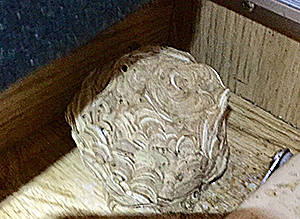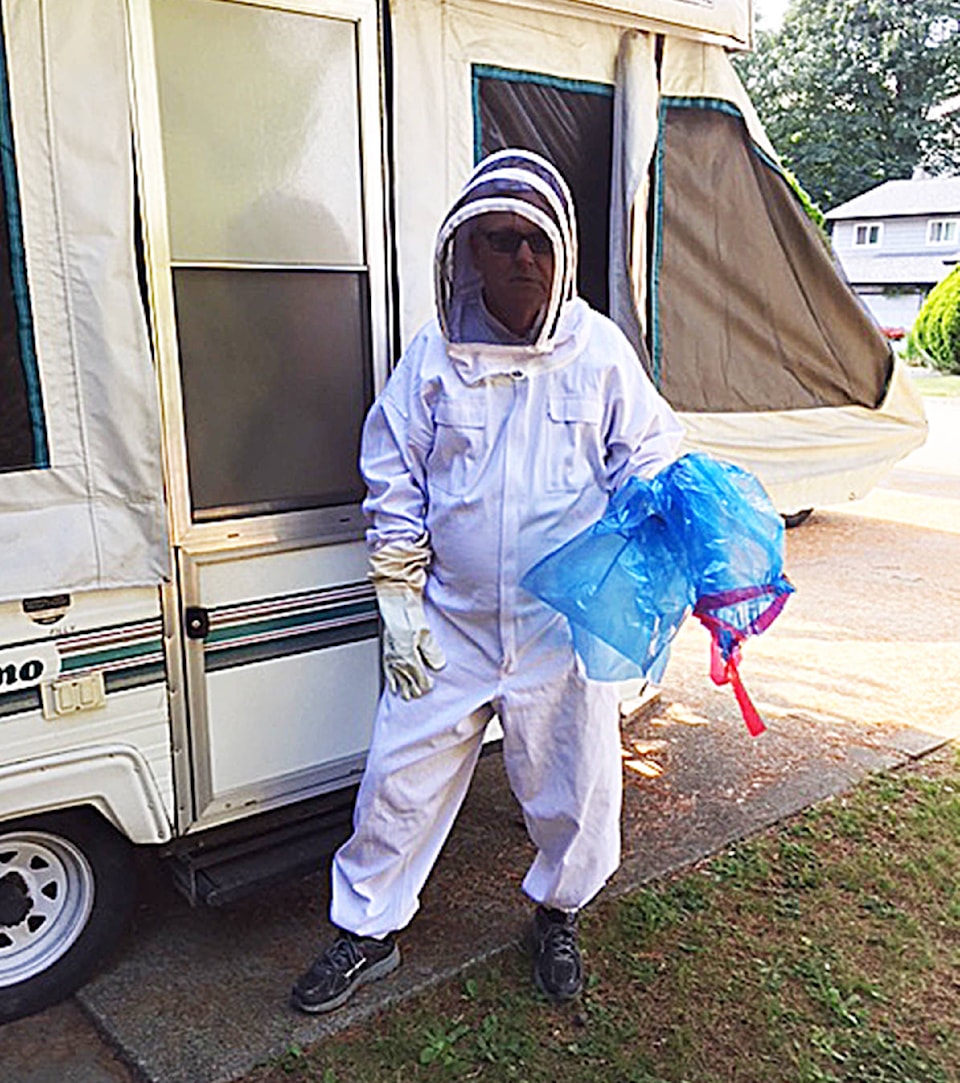The egg chambers in a wasp’s nest are six-sided hexagons. This best-of-all shapes for space stations allows cells to interlock for maximum space and strength.
Wasps – with no training in math – know this.
Few of us could build a hexagon, and none from wood chewed into paste and turned into paper, untreated. Because wasps – unlike people – won’t eat chemicals.
None of this impressed me when I found a nest in my tent trailer, on a shelf next to my bed, unattached, as if the queen who built it realized it wasn’t going to fall.
Tell me that’s just ‘instinct.’
Still, I cursed – loudly.
I’d planned to hang out with ‘Mexican’ Mike and Anna at the Road Kill Grill in Clinton before a little fishing while exploring Highway 20 towards Bella Coola.
“Got a wasp nest,” I told Joe on a hike with the local outdoor club.
I was casting (get it) for ideas.
“Insecticide spray,” he said.
“Won’t use one. Don’t want to kill them.”
Joe’s eyebrows lifted in puzzlement and concern.
“Good luck with that.”
I’d need it. I’ve been stung by hornets that wouldn’t accept an apology when I walked into their nest. Pain from a leatherjacket’s sting lasted days. I’ve considered taking revenge like Captain Ahab after losing a leg to Moby Dick.
But, I don’t. Wasps help with pollination as bees decline.
The Honeybee Centre in Surrey (National Geographic, July, 2018) says monocultures like blueberries lack the nutrition bees need and make them vulnerable to disease. Wasps eat flies and centipedes that ravish food crops.
Without wasps, the planet would be pest ridden, economies crash. Besides, most species aren’t aggressive.
Mine buzzed about my head, but – unlike some political bullies - didn’t start a fight.
Still, I had to get rid of them. Blow-torching is the preferred method for a lot of guys on Youtube. Convince me they’re smarter than wasps, or more socially adjusted than the collaborative animals they turn into bits of charcoal.
In one video, Wagner’s Rise of the Valkyries (Apocolypse Now), soars in the background. Remember Robert Duvall’s “I love the smell of napalm in the morning,” as U.S. jets set enemy villagers and huts ablaze?
Drowning wasps in toxic foam seemed merciful. One insecticidal ingredient – cypermethrin – lasts 84 days in the air, on walls, beds. It’s lethal for bees, fish, and the family cat.
I watched a man in shorts empty two cans into the nest on his walkway.
“Listen to the noise they’re making,” he exclaims excitedly.
Wasps aren’t quiet as their babies are incinerated.
Days passed.
“Don’t know what to do,” I told Barry.
An RV camper, he knew about nests in trailers.
“Slip it into a garbage bag,” he advised. “At night, when they’ve settled.”
That evening – my nerves steeled by Barry’s first-hand experience – I grabbed a bag.
As predicted, most wasps had settled in the nest, but several clustered beside it, ready to sound an alarm. I remembered what stings felt like, swallowed my pride, and retreated.
ARMS has a bee workshop, Saturday, 10 a.m.
“Borrow a bee suit,” my wife said.
“Sure, no problem,” said officer manager Greta.
White bee suits resemble the hazardous materials gear cops put on to clean out meth labs. That night – fearlessly now – I re-entered the trailer, scooped the nest into the bag and tied it shut, feeling as pumped up with manhood as Arnold Swartzenegger.
“Got ’em,” I shouted to my wife.
Then, with the mask off, but still wearing the suit, I drove down Neaves Road to an isolated side road. Any visitors that late were likely idiots dumping building materials or a mattress, events I’d reported to the pollution hot-line.
There was a full moon, and coyotes yipping when I turned the bag inside out over a rotten log, trotted back to my van, drove forward a bit, and waited. When I was sure no wasps followed, I stepped out to retrieve the bag.
Give a hoot, don’t pollute is my motto.
That’s when I noticed headlights, a vehicle at the junction on Neaves. My lights were on, too. The driver had to have seen me; had to have wondered what I was up to, He crept forward, in his dark SUV, stopping periodically, as if debating whether to turn around – difficult on that narrow road.
I stood by my door and watched him ease past me, no-doubt dying to know what someone in a white HAZMAT suit what up to in no-man’s-land, under a full moon. But not enough to stop and ask. Or, hoping perhaps, what he was up to would remain a secret.
Two days later, I found more wasps where the nest had been, probably foraging for food when I highjacked their home. Survivors grieve any losses, then start to rebuild, much like humans after fires or floods.
That night, I plopped a plastic container over them, slipped a stiff piece of paper under it, and put the enclosure in another bag, clumsily squashing an unfortunate few. Collateral damage, I tell my conscience. In any struggle over territory, I assure it, there are bound to be casualties.
I wore the bee suit again when I drove the last wasp detainees down Neaves to their relocation camp. Again, coyotes baled to a full moon, but no humans bore witness.
A couple of days later, I thanked Barry.
“Wouldn’t have dared to bag them if you hadn’t done it before, pal.”
“Me? Bag them? Never,” Barry said. “Just heard some guys have.”
“But, you said …” I blurted.
“Nope. Had a nest on the house once. Knocked it off with the hose.”
Jack Emberly is a retired teacher, local author and environmentalist.

